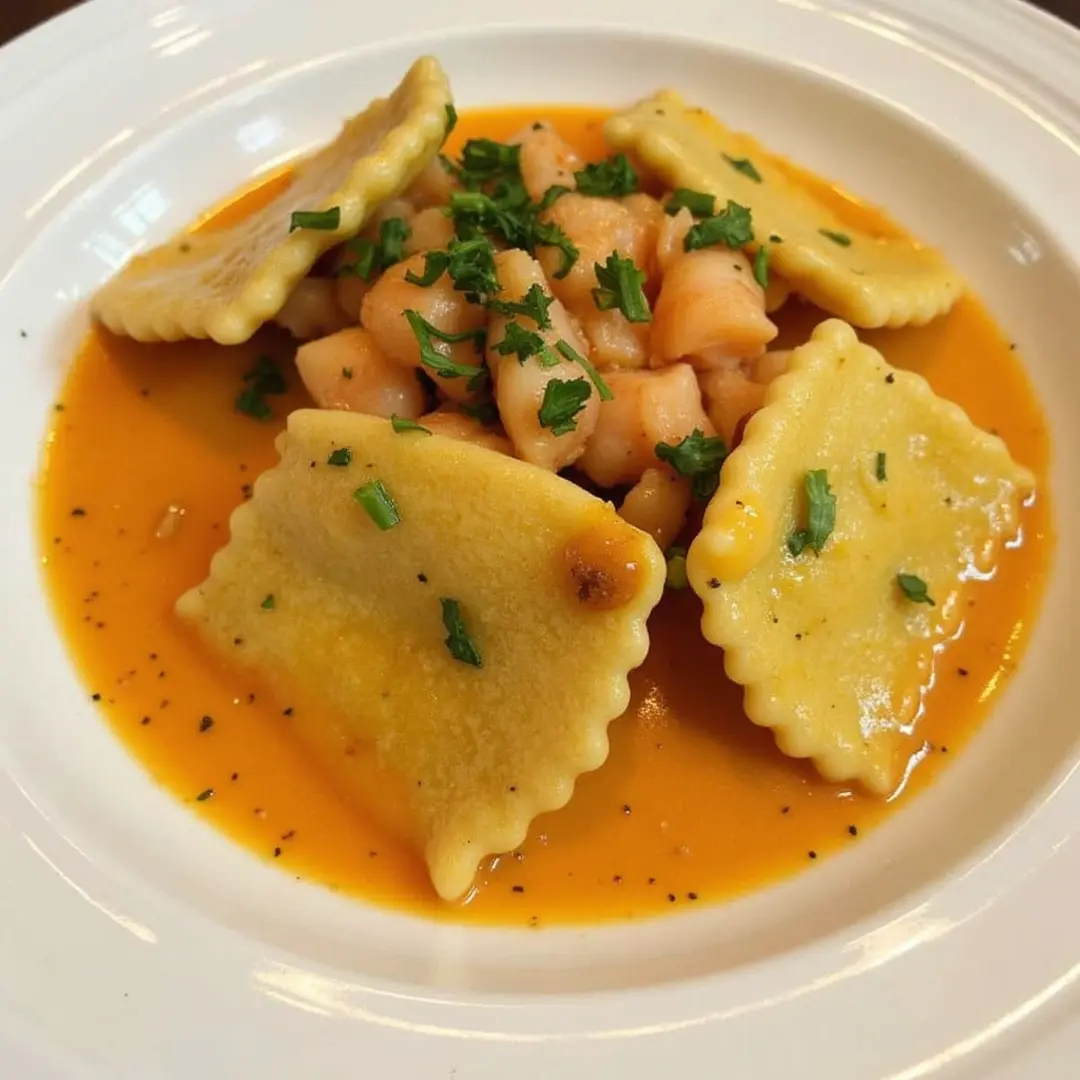Introduction and History of Lobster Ravioli
Introduction to Lobster Ravioli
Lobster ravioli is a culinary masterpiece that combines the delicate flavors of fresh pasta with the rich, savory essence of lobster. This dish represents a marriage of simple ingredients and sophisticated techniques, resulting in a meal that’s as visually appealing as it is delicious. Lobster ravioli has earned its place in gourmet cuisine, often featured on fine dining menus and reserved for special occasions due to its luxurious appeal.
The popularity of lobster ravioli lies in its ability to transform humble ingredients into a decadent experience. The tender pasta envelopes a creamy lobster filling, often enhanced with complementary flavors like basil, lemon zest, or a hint of seafood mousse. Topped with a velvety sauce, such as a lobster bisque reduction or a light lemon vinaigrette, this dish elevates the art of Italian cooking.
Among the many interpretations of lobster ravioli, Gordon Ramsay’s version stands out as a true icon. His meticulous approach to crafting this dish—from using the less glamorous parts of the lobster to creating a robust stock—demonstrates a mastery of flavor that has made his recipe a hallmark in modern cuisine.
Table of Contents
History of Ravioli
The origins of ravioli trace back to medieval Italy, where these small pasta parcels were filled with locally available ingredients, ranging from cheese and vegetables to meats. Originally created as a way to use leftovers creatively, ravioli soon became a staple in Italian households.
Over centuries, the concept of ravioli evolved, with each region of Italy introducing its own variations. Traditional fillings, such as ricotta and spinach, gave way to more innovative creations as global cuisines influenced Italian cooking. Modern adaptations, like lobster ravioli, showcase how this classic dish has embraced luxury ingredients, reflecting the evolution of ravioli from a humble comfort food to a sophisticated culinary delight.
Ingredients and Preparation Techniques for Lobster Ravioli
Key Ingredients for Lobster Ravioli
Lobster Ravioli : Choosing Fresh vs Frozen
The star of lobster ravioli is, of course, the lobster. Fresh lobster is ideal, offering unparalleled flavor and texture that make the dish truly luxurious. When selecting fresh lobster, look for a firm shell and ensure it’s lively if purchased live. However, frozen lobster meat can be a convenient alternative, especially when fresh options are not readily available. Thaw frozen lobster properly in the refrigerator to maintain its quality and prevent a rubbery texture.
Pasta Dough: Importance of Texture and Freshness
Fresh pasta dough is essential for making ravioli that is tender yet durable enough to hold the filling. The ideal dough should be pliable, easy to roll, and thin enough to cook quickly without breaking. A simple mixture of flour, eggs, and a pinch of salt is all it takes, but kneading the dough to the right consistency and allowing it to rest ensures the best results.
Supporting Ingredients: Salmon Mousse, Herbs, and Lemon Zest
A touch of salmon mousse is often added to the lobster filling to provide a smooth, creamy texture that complements the lobster’s flavor. Fresh herbs like basil and parsley add an aromatic element, while a dash of lemon zest enhances the filling with a bright, citrusy note that balances the richness of the seafood.
Step-by-Step Guide to Making crazy Lobster Ravioli
Preparing the Lobster Filling
Start by steaming or boiling the lobster until the meat is just cooked through. Extract the meat from the claws, knuckles, and tail, and dice it finely. Blend the lobster meat with salmon mousse, lemon zest, and fresh herbs, seasoning with salt and pepper to taste. Chill the filling in the refrigerator to make it easier to handle.
Rolling and Cutting Pasta Dough
Using a pasta machine or rolling pin, roll the dough into thin sheets, aiming for a consistent thickness of around 1–2 millimeters. Cut the sheets into circles or squares using a pastry cutter, ensuring uniform sizes for even cooking.
Assembling Ravioli: Tips for Sealing and Avoiding Air Pockets
Place a small spoonful of the lobster filling in the center of each pasta shape. Brush the edges with a beaten egg yolk to act as an adhesive. Cover with another pasta sheet or fold over, pressing firmly around the filling to seal. Be careful to eliminate any air pockets, as these can cause the ravioli to burst during cooking.
Creating the Perfect Lobster Stock
Importance of Lobster Shells
Lobster shells are the foundation of a rich, flavorful stock. Instead of discarding them, roast the shells in the oven to intensify their flavor, a key step in creating a deeply aromatic base for sauces or poaching.
Adding Aromatic Vegetables and Deglazing with Brandy
In a large pot, sauté diced carrots, onions, celery, garlic, and a stalk of lemongrass in olive oil until softened. Add the roasted lobster shells and a tablespoon of tomato paste, cooking for a few minutes to develop flavor. Deglaze the pot with a splash of brandy, scraping up any browned bits for added depth.
Reducing Stock to Enhance Flavors
Pour in a mix of veal and chicken stock, then bring the mixture to a boil before lowering to a simmer. Let the stock reduce for 30–40 minutes, allowing the flavors to concentrate. Strain the liquid, discarding solids, and continue reducing until it reaches a rich, thickened consistency. This stock will be the perfect accompaniment for your lobster ravioli.
Cooking and Plating Lobster Ravioli
Cooking Lobster Ravioli
Boiling vs Poaching: Differences in Results
Cooking lobster ravioli is a delicate process that can make or break the dish. Boiling is the traditional method, involving a large pot of salted, gently simmering water. While effective, boiling requires careful attention to prevent the ravioli from breaking apart due to turbulence. Poaching, on the other hand, uses a flavorful lobster stock at a lower temperature, adding depth to the pasta while preserving its structure. Poaching is the preferred method for achieving tender ravioli infused with rich, complementary flavors.
Tips to Avoid Overcooking Lobster Ravioli
Lobster ravioli cooks quickly, typically in 2–3 minutes. Overcooking can lead to mushy pasta and a compromised filling texture. To avoid this, monitor the ravioli closely as it cooks. Remove them from the water or stock as soon as they float to the surface, signaling they’re done. Work in small batches to prevent overcrowding, which can cause uneven cooking.
Flavoring with Lemon Vinaigrette
After cooking, toss the ravioli gently with a light lemon vinaigrette. This step adds a tangy brightness that complements the richness of the lobster filling. Whisk together lemon juice, extra virgin olive oil, and a pinch of salt to create the vinaigrette. Be cautious not to overpower the dish—lightly coat the ravioli to enhance, not mask, the flavors.
Plating Lobster Ravioli Like a Pro
Presentation Tips from Gordon Ramsay
Gordon Ramsay emphasizes the importance of elegant plating to elevate any dish. For lobster ravioli, focus on clean, intentional presentation. Use large white plates to highlight the vibrant colors of the ingredients and create a professional aesthetic.
Using Tomato Chutney as a Base
Spread a spoonful of tomato chutney on the plate as a base for the ravioli. This chutney, made with slow-cooked diced tomatoes, olive oil, and fresh basil, provides a sweet and tangy contrast to the savory ravioli. The bright red hue also adds a visual pop.
Adding Microgreens for a Visual and Flavor Boost
Finish the plating by garnishing the ravioli with microgreens such as basil or sorrel. These add a subtle herbal note while enhancing the dish’s presentation with their fresh, green color. For a final touch, drizzle a bit of reduced lobster stock around the plate to tie all the elements together and create a visually appealing composition.
Variations and Pairings for Lobster Ravioli
Creative Variations
Substituting Lobster with Crab or Shrimp
While lobster is the classic filling for this dish, substituting it with crab or shrimp provides delicious alternatives. Crab meat offers a slightly sweeter flavor, making it a great option for a refined yet less expensive dish. Shrimp, on the other hand, adds a firm texture and a mild seafood taste. Both options pair well with the same complementary ingredients, like lemon zest and fresh herbs, ensuring a flavorful result.
Vegan Adaptations with Plant-Based Seafood Alternatives
For those seeking a vegan version of lobster ravioli, plant-based seafood alternatives can be a game-changer. Ingredients like hearts of palm or artichokes can mimic the flaky texture of lobster, while seaweed or miso paste can replicate its oceanic flavor. Pair these with vegan pasta dough made without eggs and use a creamy cashew-based filling to achieve a luxurious mouthfeel. This variation offers an inclusive twist on the classic dish.
Pairing Lobster Ravioli
Recommended Wines
The delicate flavors of lobster ravioli pair beautifully with white wines that enhance its richness without overpowering it. A Chardonnay, particularly one that is lightly oaked, complements the buttery texture of the lobster filling. For a crisper option, Pinot Grigio brings bright acidity and citrus notes, balancing the dish’s richness.
Side Dishes
Simple, complementary side dishes can complete the meal without overshadowing the ravioli. Garlic bread, with its crunchy texture and garlicky aroma, is a perfect accompaniment. Alternatively, a light salad with mixed greens, a citrus vinaigrette, and perhaps a sprinkle of shaved Parmesan provides a refreshing contrast to the richness of the ravioli. Together, these pairings elevate lobster ravioli to a full, satisfying dining experience.
FAQs About Lobster Ravioli
How do I store leftover lobster ravioli?
Leftover lobster ravioli should be stored in an airtight container in the refrigerator. If the ravioli is uncooked, sprinkle a little flour on the surface to prevent sticking and layer parchment paper between them. For cooked ravioli, store them without sauce to avoid sogginess. Consume leftovers within 2–3 days to ensure freshness and quality. Reheat cooked ravioli gently in a pan with a splash of water or stock to restore their texture.
Can I freeze homemade ravioli?
Yes, homemade ravioli freezes exceptionally well, making it a convenient option for meal prep. Arrange the ravioli in a single layer on a parchment-lined baking sheet and freeze until firm. Once frozen, transfer them to a resealable freezer bag or container. Frozen ravioli can be cooked straight from the freezer—just add an extra minute or two to the cooking time.
What’s the best type of pasta dough for seafood fillings?
The best pasta dough for seafood fillings is a traditional egg-based dough made with a combination of all-purpose flour and semolina flour. This mixture provides the perfect balance of elasticity and firmness, ensuring the ravioli hold their shape during cooking. The dough should be rolled thin enough to highlight the delicate seafood filling without being overpowering.
How can I prevent ravioli from breaking during cooking?
To prevent ravioli from breaking, handle them gently and avoid overcrowding the pot. Use a large pot of simmering water or poaching stock, as a rapid boil can create turbulence that may tear the pasta. Cook ravioli in small batches and remove them as soon as they float to the surface.
What’s a good alternative to lobster for this dish?
If lobster is unavailable or too expensive, crab or shrimp make excellent substitutes. Both provide a similar seafood flavor profile and pair well with the same complementary ingredients. For a vegetarian twist, you can use ricotta cheese blended with herbs and a touch of lemon zest for a creamy, flavorful filling.

